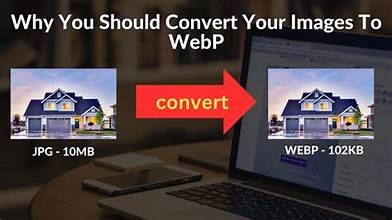WebP is a modern image format developed by Google. It provides smaller file sizes compared to JPG and PNG while maintaining excellent quality. Unlike older formats, WebP supports transparency and even animation, making it versatile for all types of websites.
Why WebP is the Best Choice for Websites
1. Faster Loading Times
WebP images are up to 30–50% smaller than JPG or PNG. Smaller files = faster load times = better user experience.
👉 Example:
- JPG (100KB) → WebP (60KB)
- PNG (200KB) → WebP (80KB)
That’s a huge difference for sites with hundreds of images.
2. Better SEO Rankings
Google directly measures page speed and Core Web Vitals in its ranking system. Optimized images help:
- Improve LCP (Largest Contentful Paint)
- Lower bounce rates
- Increase visibility in search results
3. Saves Bandwidth and Hosting Costs
Large image libraries can eat up server space. WebP reduces hosting usage by up to 70%, which also lowers bandwidth costs for sites with high traffic.
4. Works Perfectly on Mobile
More than 60% of traffic in 2025 comes from mobile devices. Since WebP files load quickly even on slower 3G/4G networks, it ensures smooth browsing for mobile users.
5. Browser Support is Nearly Universal
Initially, WebP wasn’t supported everywhere. But now, over 95% of browsers (including Chrome, Firefox, Safari, Edge, Opera) support it. That makes it safe to use across nearly all devices.
How to Start Using WebP
- Convert Your Existing Images
- Use online tools like ShrinkWebPSize.com
- Or software like Photoshop, GIMP, or ImageMagick
- Use WebP Plugins for WordPress
- ShortPixel
- Imagify
- Smush
- Set Up Fallbacks (Optional)
- Keep JPG/PNG copies for older browsers (rarely needed in 2025).
Real-World Example
A blog with 200 images (average 150KB each):
- Without WebP → ~30MB total load
- With WebP → ~12MB total load
➡ Result: Website loads 2x faster and ranks higher in Google within weeks.
FAQs
Q1: Does WebP reduce quality compared to JPG/PNG?
No. WebP keeps visual quality the same while shrinking file size.
Q2: Can WebP replace PNG for transparent images?
Yes, WebP supports transparency like PNG but with smaller size.
Q3: Do I need coding skills to use WebP?
No. Online tools and WordPress plugins make it easy.
Final Thoughts
WebP is no longer optional—it’s the standard image format for modern websites. It improves speed, SEO, mobile performance, and user experience. If you haven’t already switched, now is the time.
👉 CTA: Compress and convert your images into WebP instantly at ShrinkWebPSize.com — free, fast, and simple.


